 Trust, but verify. Photo by The Official CTBTO Photostream. |
A couple months ago, I wrote about the conflict between my conservative philosophy on the role of the feds in K–12 education and states’ inability to sufficiently address (and, in some cases, their near indifference to) the achievement gap.
In short, my default setting is that most major K–12 decisions should be made by states and the entities they create for these purposes. But evidence since the mid-1960s shows that this formula has led to lots of disadvantaged kids falling and staying behind.
I’m unable to fully embrace a “Therefore-Uncle-Sam-Must-Take-Charge” approach because, ideology aside, experience shows that federal pronouncements and mandates run into a bevy of implementation roadblocks and seldom translate into the results we hope to see.
This tension is front and center in the debate—if you can call virtual inaction “debate”—over ESEA reauthorization. Many on the right simple want USED out of this business entirely. Indeed, I was in a state capital earlier this week, and a long-serving conservative state legislator told me that everything the Department has done since its inception 30 years ago has been a net negative for kids.
Hmm...
I have no reason to believe that ESEA will get reauthorized any time soon, partially because the administration appears to have concluded that its waiver strategy accomplished enough to make any reauthorization push not worth the effort.
I remain skeptical of the waiver enterprise. While it certainly released the pressure building up in local communities over the un-nuanced AYP rules, this, I worry, will reduce the sense of urgency about the achievement of disadvantaged kids in “unidentified schools.” I hope that states and districts will continue to focus on the needs of these kids even as the federal government stops staring over their shoulders. But pre-NCLB behavior and results suggest we can’t assume as much.
All of this is on my mind because yesterday was the 11th anniversary of NCLB. At this time last year, my colleague Eduwonk wrote about his interview with President George W. Bush, which centered on this landmark law. That conversation is worth revisiting.
The Bush presidential center, which is to open soon, has already begun work on a range of projects, including K–12 education, with accountability as an area of focus. Kerri Briggs, my former USED colleague and head of the center’s ed-reform practice, wrote about these issues yesterday. I’m very happy they are closely monitoring waiver activity and the consequences for all students.
Others are interested as well. Ed Trust has summarized the waivers, and the Center for American Progress is on the scene, too.
I don’t know what the right answer is. My resume, somewhat embarrassingly, bears that out: I worked for a White House and USED that were committed to faithfully implementing NCLB. I also worked for a congressman who voted against it and an SEA that received an ESEA waiver.
I’d really like to think that it’s not that I’m a flip-flopper on the issue but, instead, that I’m looking for a way to marry the best aspects of a number of well intentioned but individually imperfect approaches.
I suspect that the right formula is some combination of state empowerment and close federal oversight and targeted activity. I’m increasingly of a mind that the current “tight-loose” approach (common standards and assessments but state/local control of just about all else) was a good post-NCLB opening bid but ultimately inadequate. Sorry Checker, Mike, Mr. Secretary, et. al.
I’m trying mightily to craft a federal K–12 posture closer to the Russian adage famously adopted by Reagan: “Trust, but verify.”
The next four years are probably going to be mostly about implementation of the last four years’ worth of policy changes. While lots of energy will be spent on the Common Core, assessment consortia, teacher evaluations, etc., I hope that we dedicate equal bandwidth to monitoring the impact of the waivers and making course corrections.